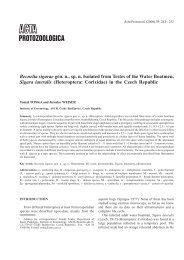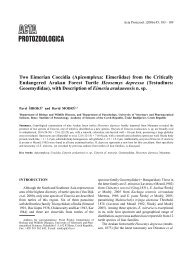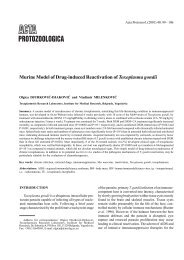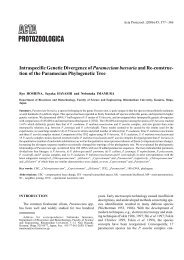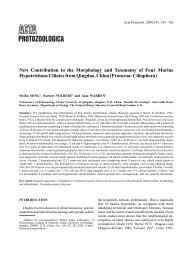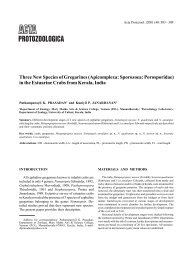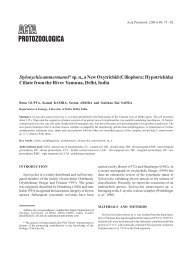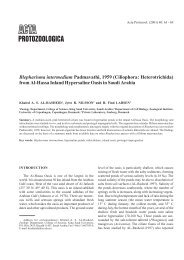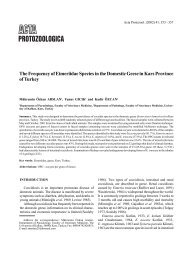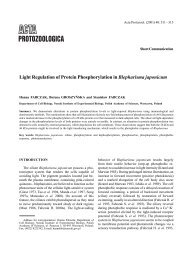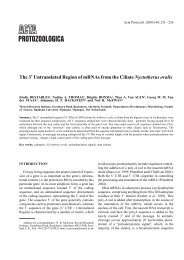The Centropyxis aerophila Complex (Protozoa: Testacea)
The Centropyxis aerophila Complex (Protozoa: Testacea)
The Centropyxis aerophila Complex (Protozoa: Testacea)
Create successful ePaper yourself
Turn your PDF publications into a flip-book with our unique Google optimized e-Paper software.
<strong>The</strong> <strong>Centropyxis</strong> <strong>aerophila</strong> complex 269<br />
is mainly brought about by accumulation of agglutinated<br />
material on the dorsal and lateral shell wall. Thus, the<br />
ventral lip is possibly not “perforated” in the strict sense<br />
of the word; this is also indicated by its general appearance,<br />
which is as in the other varieties (Figs. 32, 38). In<br />
the scanning electron microscope, a lip perforation was<br />
seen in several small (transparent; Figs. 41-47, 48-53)<br />
and large (“typical”) C. sylvatica specimens (Figs. 54,<br />
55, 56, 57), showing that the species cannot be recognised<br />
by size.<br />
Lobose pseudopods and their movements, as well as<br />
two contractile vacuoles, were described by Bonnet<br />
(1961) in C. sylvatica var. minor. Rauenbusch (1987)<br />
and Lüftenegger et al. (1988) provided some helpful<br />
scanning electron micrographs showing that shell wall<br />
structure highly depends on the substrate the organisms<br />
live. Lüftenegger et al. (1988) provided also detailed<br />
morphometrics showing that pseudostome features are<br />
more variable than the length and width of the shell.<br />
Scattered measurements were given by other authors<br />
(Bonnet and Thomas 1955, Rosa 1971), broadening,<br />
however, Deflandre’s limits only slightly: 56-113 (length)<br />
x 47-100 (width) x 45-68 (height) µm; pseudostome<br />
23-55 (long axis) x 20-32 (short axis) µm.<br />
Morphometry<br />
Basic statistics show that most variables have usual<br />
coefficients of variation and the number of specimens<br />
investigated is sufficient because mean and median<br />
hardly change if 127 or 217 specimens are analysed<br />
(Table 1). Of course, variation is distinctly lower in the<br />
selected specimens (Table 2). Only a few of the variables<br />
measured are normally distributed, viz. shell width,<br />
ratio shell length: abdomen length, and ratio shell width:<br />
abdomen length. All other features are slightly skewed to<br />
the left.<br />
Analysis of variance: If the 30 selected specimens of<br />
each are compared (all intermediate shells removed, see<br />
Method section!), all variables tested (length, width…)<br />
are significantly different (p ≤ 0.001), except the ratio<br />
shell length: abdomen length, that is, the three taxa can<br />
be clearly distinguished. If the 127 randomly chosen<br />
specimens are compared with the 30 selected specimens<br />
of either C. <strong>aerophila</strong> <strong>aerophila</strong> or C. <strong>aerophila</strong><br />
sylvatica, highly significant differences (p ≤ 0.001 to<br />
p ≤ 0.05) still occur in most variables, except for the<br />
ratios; in contrast, only shell height, shell length, short<br />
pseudostome axis, and the length: width ratio are different<br />
(p ≤ 0.05) in C. <strong>aerophila</strong> sphagnicola, indicating<br />
that this variety is intermediate between the two others.<br />
Finally, when the 30 selected specimens of each are<br />
pooled (= 90 specimens) and compared with the 127<br />
randomly chosen specimens, all variables become indistinguishable<br />
(p ≥ 0.05).<br />
Frequency distributions and relationships between<br />
variables (only some representative examples each are<br />
shown, Figs. 62a-f): Frequency distributions show curves<br />
with a single peak (Fig. 62d). Likewise, rather homogenous<br />
clusters are formed in the randomly chosen<br />
specimens, when variables are plotted against each<br />
other (Figs. 62a-c). In contrast, two distinct clusters are<br />
usually formed, if the selected specimens are plotted<br />
(Figs. 62e, f): one contains C. <strong>aerophila</strong> <strong>aerophila</strong> and<br />
C. <strong>aerophila</strong> sphagnicola, the other C. <strong>aerophila</strong><br />
sylvatica.<br />
DISCUSSION<br />
Morphometry<br />
Although species cannot be proven mathematically,<br />
some basic statistics are often useful to distinguish them<br />
more properly. As concerns the present material, neither<br />
the coefficients of variation (Table 1) nor frequency<br />
distributions (Fig. 62d) and relationships between the<br />
variables tested (Figs. 62a - c) give any indication that<br />
the randomly chosen specimens consist of more than<br />
one species. Variation coefficients (Tables 1, 2) are of<br />
the same order of magnitude as in multicellular organisms<br />
(Mayr 1975) and other protozoans, e.g. ciliates<br />
(Foissner 1984, 1993), and as in testate amoebae in<br />
general (Lüftenegger et al. 1988, Wanner 1991, Foissner<br />
and Korganova 1995). Only the pseudostome variables<br />
have coefficients higher than 20%; however, this seems<br />
to be a general feature of testacean shells (Lüftenegger<br />
et al. 1988, Wanner 1991).<br />
However, the situation changes drastically in the<br />
selected material, that is, when all intermediate specimens,<br />
which could not unequivocally assigned to one of<br />
Deflandre’s varieties, are excluded (Table 2). <strong>The</strong>n,<br />
three taxa can be distinguished by analysis of variance<br />
and at least two in scatter diagrams (Figs. 62e, f), just as<br />
different species were compared (Lüftenegger et al.<br />
1988). <strong>Centropyxis</strong> <strong>aerophila</strong> sylvatica is separated by<br />
its larger dimensions, while C. <strong>aerophila</strong> <strong>aerophila</strong> and<br />
C. <strong>aerophila</strong> sphagnicola are distinguished mainly by<br />
the shell proportions (Table 2): the former is broadly<br />
elliptical (66.6 x 56.4 µm), the latter almost circular<br />
(66.2 x 65.6 µm); furthermore, the long pseudostome<br />
axis is distinctly larger in C. <strong>aerophila</strong> sphagnicola



